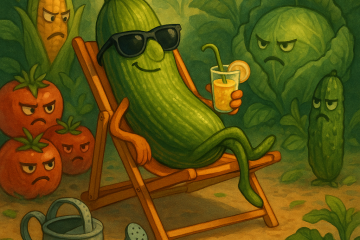The Prepper’s Guide to the Passive-Aggressive Garden: How to Grow Food Without Wooing It
Loading the Elevenlabs Text to Speech AudioNative Player...Let’s be honest, not every tomato in the garden deserves a love letter and a back massage. Sometimes, you need crops that are more “independent cat” than “needy Read more…




28 Comments
Carrie · May 23, 2013 at 3:13 am
Thank you for the heads up on amaranth. I had heard of it but had never tried it. It sounds easy to grow and something definitely worth adding to the garden!
Crisco · May 23, 2013 at 3:36 am
Kellene, you’re such a tease! You know we want to know more. How do we use amaranth and grow it? We know you know! Seriously, I have been trying all kinds of new grains, seeds and flours. Flax , teff, farro, hemp seeds, coconut, almond, brown rice and bean flours have expanded my repertoire. Amaranth is ‘untested waters’ and requires an in depth article and you’re the one to write it! Maybe you could include information on wheat-less gluten free bread recipes too. Genetically engineered wheat is really scaring me these days.
Thanks for all you do. Keep the information coming. We all have ‘miles to go before we sleep’.
Kellene Bishop · May 23, 2013 at 9:08 am
I’m working on it, Friend. I’m working on it. I was just SO excited about it I had to at least get SOMETHING out there, right? 🙂 *big grin* BTW, Teff is my absolute FAVE!
Jackie · May 24, 2013 at 1:22 am
Where are ya’ll getting the TEFF? What is the price range for 25#?
Thanks
Jackie
Yolanda · May 23, 2013 at 9:30 am
…. googling for “amaranth seeds for sale…”
Kellene Bishop · May 23, 2013 at 3:08 pm
Yolanda, you’ll want to look for the grain as that’s the same as the seeds you’ll plant. Obviously, organic is the best way to go. I get mine from Baker Creek at rareseeds.com 🙂 They have a BEAUTIFUL variety.
Jennifer Edwards · May 23, 2013 at 1:59 pm
I had heard that a wild growing weed out here was also amaranth. Other names for this “weed” are red root and pig weed. It gets little black seeds in the tops and the plant is edible…much like spinach. Do you know if this is true? It doesn’t look like those plants in the picture, but sounds identical in it’s description.
Kellene Bishop · May 23, 2013 at 3:09 pm
Yup, it’s true that it’s in the pigweed family and yes, the leaves do taste like spinach and there are about 60 different species. Some species are better for the leaves than others, but I haven’t found one yet that I didn’t care for. 🙂
Ruth · May 23, 2013 at 3:40 pm
We can accommodated large plants and I’m assuming larger varieties would be more suited for grain but there are so many choices what do you recommend for someone with space? Are all varieties similar in taste?I Also where do you purchase your seeds?
Kellene Bishop · May 23, 2013 at 4:06 pm
I’ve found that all of the varieties sold by Baker Creek Heirloom seeds (rareseeds.com) are good for both leaves and grain. The plants are tall as opposed to bushy. It’s been kind of funny learning how entire civilizations missed the alternative use for amaranth. Those who used it for grain didn’t realize it could also be used for the leaves and vise versa.
Brooke · May 23, 2013 at 5:42 pm
Kellene:
I was wondering about storing Amaranth. I know most suggest storing wheat in the original harvested form versus the ground flour. I am going to do both. I will put flour with oxygen absorbers and sealed in food grade containers in order to have some flour in containers that aren’t subject to outside environmental circumstances. Have you tried storing this either as grain or flour and what method did you use? Also, you mentioned the leaves were spinach-like. Would you try canning it in a pressure canner? I will definitely purchase every variety Baker Creek has as soon as I line out these details. And if you have any exchange ratios on amaranth flour in baking recipes, please share! Thank you and you’re awesome!
Kellene Bishop · May 23, 2013 at 11:12 pm
The Amaranth grain is so small, it’d be a mistake, I believe, to store it as a flour. It’s far too easy to grind even if you only have a mortar and pestle. You will lose far too many valuable nutrients by storing the flour long-term.
Dried goods should never be canned in a pressure canner.
I store mine as a whole grain with a little bit of diatomaceous earth in the 4 gallon bucket (about 2 T. of it.) For more info on diatomaceous earth please use our search bar here.
Brooke · May 24, 2013 at 2:05 am
Just to clarify, did you mean it’s impossible to pressure can the leaves (not the grains) in the same manner you would spinach? Sorry if I am confused 😛
Kellene Bishop · May 24, 2013 at 2:19 am
I stated that dried goods should never be pressure canned. As for the leaves, I suppose they could be dehydrated just like chard and spinach are.
Connie · May 23, 2013 at 5:58 pm
I planted amaranth last year in an 8’x8′ square raised bed on the south side of the house where it was visible to the street. I put four of them in the center, with chamomile all around the edges. It was a beautiful bed, and I figured that was a good way to expand my garden because passersby would just assume they were flowers and not food. I was looking forward to the harvest–but alas, the frost got to it first! I never even got to harvest and eat any leaves. I was sooo disappointed!
I’m really looking forward to learning how to cook with amaranth!
John · May 24, 2013 at 3:43 am
I have a lot of deer in my neighborhood. I am wondering if I will have to fence in the amaranth, or can I just throw the seeds to the wind in the open fields around where I live. If I do that, will the deer eat all of it up when it sprouts from the ground?
Kellene Bishop · May 24, 2013 at 8:06 am
I know this is going to sound weird, but a good deer strategy is to have a male urinate around the property line that you don’t want the deer to infiltrate. This works well for repelling wolves too. You’ll have to repeat it after a good rain though.
Felistorm · May 27, 2013 at 10:04 pm
Unfortunately I am allergic to pigs weed (another name for amaranth from what I understand) so can’t have it. Can’t have wheat either but can have corn and rice and am looking for other alternatives. Any suggestions? (I am curious to try acorn flour too)
Kellene Bishop · May 28, 2013 at 3:01 am
Yup, there’s LOTS of other options…some of my favorites are teff, millet, farro, quinoa, and kamut! SO dang yummy!
windy · May 29, 2013 at 1:02 am
I have been looking for amaranth– but I don’t see any that grow in just 45 days which would be a big help in Maine. Do you know the specific type that only takes 45 days? The ones in Bakers Seeds are either much longer (120 days) or they don’t specify.
Kellene Bishop · May 29, 2013 at 1:49 am
You get a MUCH shorter growth time by using the Mittleider Gardening Method. And yes, there are different species which take less time to grow. But I’ve grown 4 different species that I got from Baker Creek and NONE of them too anywhere near the 120 days. I don’t know all of the different amaranths yet, (there are 60 to 70) but I do know that the amaranthus caudatus has the shortest season which is 45 to 75 days which means with the Mittleider Gardening Method you could get it as quickly as 30 to 50 days. Sweet, eh? 🙂
LeeAnn · May 29, 2013 at 7:19 pm
Be careful where you plan amarath. It re-seeds and can become a noxious weed in your garden. It is a beautiful productive plant worth growing but be careful it doesn’t become a pest.
Kellene Bishop · May 29, 2013 at 10:38 pm
It doesn’t “become a noxious weed”. It doesn’t transform it’s biological make-up. It is either amaranth or it’s not. In fact, it’s odd that you would say this because the amaranth has the ability to self-regulate, meaning that if a person were to plant a lot of seed in an area, it will naturally thin itself out and under produce for want of more oxygen and circulation and if a person plants only a little bit in a particular area then it will branch out and expand a great deal, which makes it that much more a favorite in my eye. If one does not harvest the seeds on it at the end of the season though, and allows it to simply die in place, then yes, it will drop its seeds and about 30-40% of those seeds will be able to endure a winter and then begin germinating in the spring. That’s what makes it such a great “survival garden” item. After all, it is a hulless grain which doesn’t require quality soil or insects or wind to germinate.
kirsten h · June 1, 2013 at 9:09 pm
ANY self seeding non hybrid plant can be a problem..
a weed is kind of defined as ” a plant where you dont want it”
heck, i have squash plants that pop up every year, and mint is downright invasive…
thats true of any plant
kirsten h · June 1, 2013 at 9:08 pm
and in a beautiful case of nature versus the big evil…
amaranth has developed round up resistance! so even if they try t poison your garden there is a good chance it will survive
Scott · July 15, 2013 at 12:13 am
Hi,
Last year I grew Red Amaranth in an18 gallon tote, and the sides were not firm enough, and it kept bowing out the tote. But it grew 8′ tall, and produced good seeds.
This year I am growing another Red Amaranth in a 4 gallon bucket, and 2 Burgundy Amaranth in a 4 gallon bucket. Self-watering.
Both are doing well, but the Burgundy plants are a good foot taller, 4′ versus 3′ at this point. Already has seed heads forming about an inch. grew taller right from the start.
Question — why do they want to “bow over’ like sunflowers? I put them in Tomato cages early, and have used bungies to keep them upright, but they REALLY want to bend over.
Should I just let them? or keep insisting they grow straight?
Scott
Zeb · December 7, 2015 at 2:51 pm
Thank you for this article!
Thank you for this article! The Baker Creek catalog came a few days ago and for the first time I paid attention to their big selection of amaranth. Now why didn’t I know before about this as a valuable source of grain instead of just looking at it as only an ornamental?
I will be trying this for sure this spring. It will be like hiding food in plain sight!
Preparedness Pro · December 7, 2015 at 3:56 pm
Well, better late than never,
Well, better late than never, right? 🙂
Comments are closed.